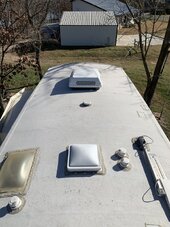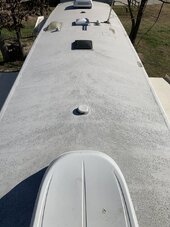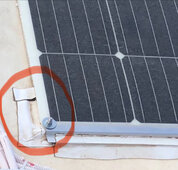Hello, I am looking for help on figuring out the best selection here to go for getting the solar panels to finish out my solar system on my 34 ft 5th wheel RV. I've got a couple of issues that I'm running into as I look for solutions. For starters, I have 3 100 AH lithium 48v batteries in the front storage along with a SP6548 from SunGoldPower that I'll be running all panels to. Till now I've just been charging batteries with my generator or shore power. I'm full time and work from my RV.
Pictures are attached of roof for reference.
Needs, my electrical goal is to cover my running wattage on a day where I'm running the rear A/C while also running my laptop and monitors and things of that nature. I'm trying to cover this load with a little wiggle room to spare. Last summer I was able to consistently measure this as about 2000 watts. So I would like to get 2400 real watts in.
One big issue I'm running into is weight. My initial plan was to get 6 550w panels and mount horizontal front to back over my front AC unit, this would run me about 400 lbs. After I got the chance to weigh my rig, however, I came in FAR above what I thought I would weigh. I could not believe I had already used up my 3000 cargo capacity. I am making changes to furniture and dumping as much as I can but that can only go so far. I have considered trying to either do an ALL flexible panel setup somehow, or to do some kind of hybrid and still get a couple 550w panels up there and then also do some flexible ones.
After some research though I'm seeing that the flexible panels might just bake the roof of the RV and end up pumping even more heat into the RV and/or could even cause burning issues? And I honestly never figured out even doing the rigid panels what the best way to do the mounting if not doing a rack over the A/C units as my roof has a significant curve. So any insight into exactly how that is supposed to happen would be helpful. I've heard unistrut and stuff but I don't see how any thing you mount on that surface won't be angled off in the direction of the roof.
Would there be any way to do slightly raised rack system and still use flexible panels? Even though I know that it sounds kinda silly because it takes away a lot of what they are good for, they are so light compared to the rigid ones.
All of these issues are difficult to sort out since I kinda need to figure out the game plan before just buying a bunch of panels.
Just for note when looking at the RV roof pictures, without racking over the A/C the places a 550w panel can fit is horizontal in front of the front A/C, and then two can be vertical behind the max fan, in front of the rear A/C.

Questions recap:
If I put 550w panels on, what would be the most elegant and sturdy mounting solution both for a horizontal mount and then for vertical?
Should I be worried about the increased heat of flexible panels?
If I should be worried about the increased heat, is there a viable racking solution that could be done to get the weight savings of flexible panels?
I understand this is kinda complicated so I appreciate anybody willing to add some insight.
Pictures are attached of roof for reference.
Needs, my electrical goal is to cover my running wattage on a day where I'm running the rear A/C while also running my laptop and monitors and things of that nature. I'm trying to cover this load with a little wiggle room to spare. Last summer I was able to consistently measure this as about 2000 watts. So I would like to get 2400 real watts in.
One big issue I'm running into is weight. My initial plan was to get 6 550w panels and mount horizontal front to back over my front AC unit, this would run me about 400 lbs. After I got the chance to weigh my rig, however, I came in FAR above what I thought I would weigh. I could not believe I had already used up my 3000 cargo capacity. I am making changes to furniture and dumping as much as I can but that can only go so far. I have considered trying to either do an ALL flexible panel setup somehow, or to do some kind of hybrid and still get a couple 550w panels up there and then also do some flexible ones.
After some research though I'm seeing that the flexible panels might just bake the roof of the RV and end up pumping even more heat into the RV and/or could even cause burning issues? And I honestly never figured out even doing the rigid panels what the best way to do the mounting if not doing a rack over the A/C units as my roof has a significant curve. So any insight into exactly how that is supposed to happen would be helpful. I've heard unistrut and stuff but I don't see how any thing you mount on that surface won't be angled off in the direction of the roof.
Would there be any way to do slightly raised rack system and still use flexible panels? Even though I know that it sounds kinda silly because it takes away a lot of what they are good for, they are so light compared to the rigid ones.
All of these issues are difficult to sort out since I kinda need to figure out the game plan before just buying a bunch of panels.
Just for note when looking at the RV roof pictures, without racking over the A/C the places a 550w panel can fit is horizontal in front of the front A/C, and then two can be vertical behind the max fan, in front of the rear A/C.


Questions recap:
If I put 550w panels on, what would be the most elegant and sturdy mounting solution both for a horizontal mount and then for vertical?
Should I be worried about the increased heat of flexible panels?
If I should be worried about the increased heat, is there a viable racking solution that could be done to get the weight savings of flexible panels?
I understand this is kinda complicated so I appreciate anybody willing to add some insight.



